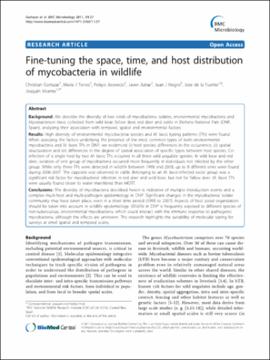| dc.contributor.author | Gortazar, Christian | |
| dc.contributor.author | Torres, Maria J. | |
| dc.contributor.author | Acevedo, Pelayo | |
| dc.contributor.author | Aznar, Javier | |
| dc.contributor.author | Negro, Juan J. | |
| dc.contributor.author | Fuente, Jose de la | |
| dc.contributor.author | Vicente, Joaquin | |
| dc.date.accessioned | 2019-08-21T22:01:39Z | |
| dc.date.available | 2019-08-21T22:01:39Z | |
| dc.date.issued | 2011-02-02 | |
| dc.identifier | oksd_gortazar_fine-tuningthe_2011 | |
| dc.identifier.citation | Gortazar, C., Torres, M. J., Acevedo, P., Aznar, J., Negro, J. J., Fuente, J. d. l., & Vicente, J. (2011). Fine-tuning the space, time, and host distribution of mycobacteria in wildlife. BMC Microbiology, 11(1). https://doi.org/10.1186/1471-2180-11-27 | |
| dc.identifier.uri | https://hdl.handle.net/11244/321220 | |
| dc.description.abstract | Background: We describe the diversity of two kinds of mycobacteria isolates, environmental mycobacteria and Mycobacterium bovis collected from wild boar, fallow deer, red deer and cattle in Donana National Park (DNP, Spain), analyzing their association with temporal, spatial and environmental factors. | |
| dc.description.abstract | Results: High diversity of environmental mycobacteria species and M. bovis typing patterns (TPs) were found. When assessing the factors underlying the presence of the most common types of both environmental mycobacteria and M. bovis TPs in DNP, we evidenced (i) host species differences in the occurrence, (ii) spatial structuration and (iii) differences in the degree of spatial association of specific types between host species. Co-infection of a single host by two M. bovis TPs occurred in all three wild ungulate species. In wild boar and red deer, isolation of one group of mycobacteria occurred more frequently in individuals not infected by the other group. While only three TPs were detected in wildlife between 1998 and 2003, up to 8 different ones were found during 2006-2007. The opposite was observed in cattle. Belonging to an M. bovis-infected social group was a significant risk factor for mycobacterial infection in red deer and wild boar, but not for fallow deer. M. bovis TPs were usually found closer to water marshland than MOTT. | |
| dc.description.abstract | Conclusions: The diversity of mycobacteria described herein is indicative of multiple introduction events and a complex multi-host and multi-pathogen epidemiology in DNP. Significant changes in the mycobacterial isolate community may have taken place, even in a short time period (1998 to 2007). Aspects of host social organization should be taken into account in wildlife epidemiology. Wildlife in DNP is frequently exposed to different species of non-tuberculous, environmental mycobacteria, which could interact with the immune response to pathogenic mycobacteria, although the effects are unknown. This research highlights the suitability of molecular typing for surveys at small spatial and temporal scales. | |
| dc.format | application/pdf | |
| dc.language | en_US | |
| dc.publisher | BioMed Central | |
| dc.rights | This material has been previously published. In the Oklahoma State University Library's institutional repository this version is made available through the open access principles and the terms of agreement/consent between the author(s) and the publisher. The permission policy on the use, reproduction or distribution of the material falls under fair use for educational, scholarship, and research purposes. Contact Digital Resources and Discovery Services at lib-dls@okstate.edu or 405-744-9161 for further information. | |
| dc.title | Fine-tuning the space, time, and host distribution of mycobacteria in wildlife | |
| osu.filename | oksd_gortazar_fine-tuningthe_2011.pdf | |
| dc.description.peerreview | Peer reviewed | |
| dc.identifier.doi | 10.1186/1471-2180-11-27 | |
| dc.description.department | Veterinary Pathobiology | |
| dc.type.genre | Article | |
| dc.type.material | Text | |
| dc.subject.keywords | animals | |
| dc.subject.keywords | animals, wild | |
| dc.subject.keywords | cattle | |
| dc.subject.keywords | deer | |
| dc.subject.keywords | mycobacterium | |
| dc.subject.keywords | mycobacterium bovis | |
| dc.subject.keywords | spain | |
